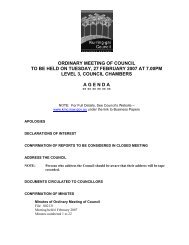pdf. 4MB - Ku-ring-gai Council
pdf. 4MB - Ku-ring-gai Council
pdf. 4MB - Ku-ring-gai Council
You also want an ePaper? Increase the reach of your titles
YUMPU automatically turns print PDFs into web optimized ePapers that Google loves.
3.5 COMMUTER PARKING (continued)<br />
3<br />
It should be noted that the spatial priority around transport interchanges<br />
should be towards pedestrians, buses and cyclists first, to encourage<br />
these modes over private vehicles. As a result, passenger pick up and<br />
drop off areas are proposed to be generally located somewhat further<br />
from the station entrances.<br />
To improve passenger pick up and drop off, it is proposed to provide<br />
additional space and to extend part time areas to full time in the larger<br />
centres, while smaller centres would have new or increased passenger<br />
pick up and drop off zones. To improve visibility and user awareness, it is<br />
proposed to supplement signage with a plate displaying the words “Pick<br />
Up and Drop Off Only”.<br />
Improved commuter pick up and drop off facilities have been considered<br />
as part of general transport interchange upgrades in the rail centres.<br />
Where appropriate, interchange upgrades are projects that would attract<br />
development contributions, and have therefore been included in the <strong>Ku</strong><strong>ring</strong>-<strong>gai</strong><br />
Town Centres Development Contribution Plan.<br />
Feeder bus services to railway stations<br />
From the Arup surveys conducted in 2007, the proportion of adult<br />
boarding passengers who travelled by bus to a railway station averaged<br />
9%, and ranged from 2% at Roseville station to 19% at Turramurra<br />
station. The relatively low proportions could be attributed to low<br />
frequency bus services and route coverage, despite all the major rail<br />
stations in <strong>Ku</strong>-<strong>ring</strong>-<strong>gai</strong> being connected to bus services.<br />
Strategies to improve access to the railway stations through bus services<br />
should provide a useful alternative to commuter parking, However,<br />
services have to be relatively direct, frequent and operate at the time<br />
commuters need them in order to be an attractive alternative. This would<br />
entail increasing the frequency of feeder services to at least 7.30pm.<br />
The Ministry of Transport has undertaken Bus Reform Planning in NSW<br />
and currently, the contract regions where <strong>Ku</strong>-<strong>ring</strong>-<strong>gai</strong> is located have<br />
undergone network planning and review. These types of issues have<br />
been raised by stakeholders and were considered by the Ministry as<br />
part of the consultation process. The revised bus networks have been<br />
introduced and are now operating.<br />
Part of the Bus Reform in NSW involves implementation of Strategic Bus<br />
Corridors, which are intended to be high frequency services connecting<br />
key regional centres in Sydney. Travel time improvements are proposed<br />
via measures such as bus priority and key intersections, dedicated bus<br />
lanes and clearways. One such route is the service between Mona Vale<br />
and Macquarie (route 36), via Gordon railway station. This service is<br />
operated by Forest Coach Lines and is particularly beneficial to residents<br />
of St Ives town centre as it would provide a frequent feeder service<br />
connecting St Ives to Gordon railway station. Strategic Bus Corridor<br />
route 7 (between Macquarie and Hornsby, via Turramurra) commenced<br />
operation on 23 March 2009 and provides an intermediate feeder role to<br />
Turramurra railway station.<br />
KEY ISSUES & DISCUSSION<br />
<strong>Ku</strong>-<strong>ring</strong>-<strong>gai</strong> Town Centres Parking Management Plan 2010<br />
p-21

















